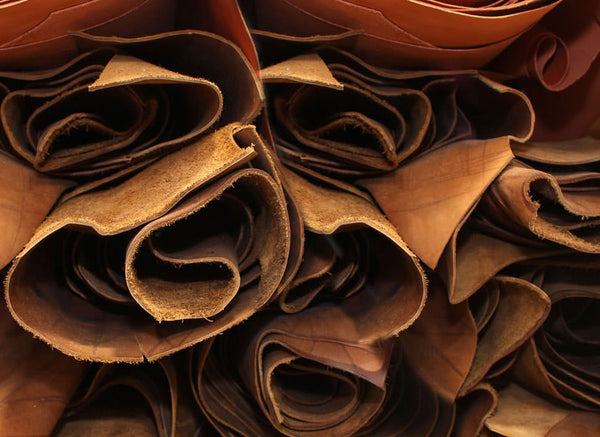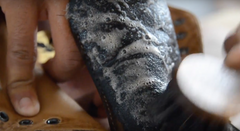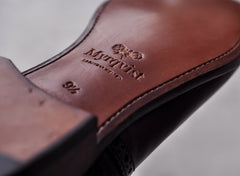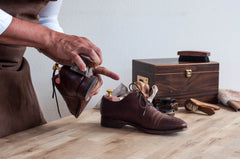What is it that really entails ’good leather’? How can a regular customer see what quality the leather has? Along with the ease of obtainin information online and comparing prices it is vital for a modern day customer to know what to look for. That’s why, we at Herrstil, have complied a leather guide where we run through what good leather is and how this will affect the end product.
The different qualities of leather can be divided in four different categories. The first, and the premium quality, is the full grain-part of the hide, the second one is top-grain, third is genuine leather and the poorest quality leather can be found in the blended leather.
The premium quality, full-grain, is the top of the hide, which means that the grain and the fibres are much tighter, as can be seen in picture 1, which results in a longer lifespan and a more natural ageing process. This part of the hide will also become a more resilient end product that will in turn tackle the issues with moist very well, and is thus a perfect type of leather for premium shoes.

Top-grain is the second best piece because it still holds part of the absolute top of the hide and thus contains the tighter grains. But, in this case the irregularities such as a tick mark, markings from the farmer, scars or fat wrinkles have been polished away and thus resulting in a less prominent fibre structure. When this happens, the tighter and more rigid structures have been removed and the grain is now approaching the horizontal fibres. In this part, the leather will be more easily stretched and not as natural in its age development. The horizontal fibres are more likely to make the surface of the product to develop wrinkles and in worst-case scenario even break the surface. Since the top has been shaved and polished away it is replaced some kind of treatment, which of course can come off from the product and result in an ugly ageing.
The third quality layer is the genuine leather part, which consists of exclusively the horizontal fibres, and thus will be weaker and not as water resistant as the other two.
Bonded leather is the worst among these since it is a product of the end shavings and left overs from the other categories. These scraps are grounded and then glued together, so the product, after a spray treatment to make it look like leather, may feel like the real thing but it will neither smell nor age properly.
The closer you get to the actual flesh of the animal that are producing the leather, the more horizontal will the fibres be and thus a worse quality. Vice versa, the closer to the top you get the tighter are the fibres and thus the better are the leather.

Picture 2 & 3 outlines from which parts on the animal the leather comes from, and thus it accurately explains why top quality leather products are more expensive to produce, since it can be made fewer of these per piece of skin. The products that are made from the pieces closer to the outlines are therefore more cost-effective and cheaper, but in general not as good as the premium. Starting on the spine, the quality will be at the top, and thus the fibres the tightest, here, and will slowly become more and more horizontal as we approach the outer lining. Products produced from the outer areas will thus have more wrinkles and worse more loose leather. Creases on the products, especially shoes, will often add a beautiful character to the shoe, but the customer will have to look out for smaller more irregular wrinkles. If these appears it is usually a result of a poor bit of leather which hasn’t been treated and tanned in the right way. Often, on cheaper shoes, these kind of wrinkles can be seen on less visible parts of the shoe, but on really bad quality shoes these wrinkles will appear even on the front. This is a result of the poor leather and tanning that dries from inside and out to in the worst-case scenario create scars in the surface.

After the leather type has been chosen, the leather enters into a process of re-establish healthy levels of oil and preservatives in it. This process is called tanning, and it will ensure that the leather will be able to age beautifully and with dignity. Different methods of tanning can be used, but in wither case the most important factor is still the quality of the leather. It does not really matter if the leather is tanned for several months if it in its core is of a bad quality.
In the tanning process the oils and preservatives are replaced, but in some cases the leather will only be tumble for a short period of time, so that just the outside of the leather will get its right balances back. In this case the inside of the leather will still be of a blue-ish nature, and thus will not contain the necessary oils and preservatives to live a long life. This happens because it is very costly to run a tumbler and the caring product, so if a leather piece is just run for a short period of time, capital can be saved on the expense of long lasting quality. The result will be a surface that after a while cracks and develop a somewhat unnatural pattern of wrinkles that was discussed earlier in the guide. You will see if this is the case if a blue lining will be visible along the sides of the piece of leather you’re looking at, but some of the manufacturers will paint or sew over the sides so it can be hard to tell in some cases.
More genuine tumbler will though make sure that the leather is tanned and treated with the right products properly. The cost of a leather product is thus in which part of the hide it is taken from and how well it is tanned. In most cases the leather will appear the same even if two different pieces have spent unequal times in the tumbler, but the result will be visible in the long run. Thus, it can be hard to identify the two different pieces with the naked eye.
Generally, there are two different methods of tanning: vegetable tanning and chrome tanning. Vegetable tanning can take up to 60 days and is thus the more expensive and traditional method of the two. Chrome tanning is more of a question of days than weeks and is therefore a much more cost effective procedure, normally this will not result in as strong and sustainable leather. However, since both of the methods have different pros and cons they are normally used in creating the same shoe, since they showcase different strengths that are suitable for different areas on the shoe.
A quality shoe is and will always be an investment for your wardrobe There are fundamental differences in quality between the different leather qualities and the treatment of it, which usually will be reflected in the price. A quality shoe thus has the potential and qualities of a long, sustainable and beautiful life that is fulfilled by correct treatment of the shoe.
After this guide we at Herrstil hope that you are more aware of the different aspects of quality in different leather types, and how it will affect the end product. We care about helping you to find the right treatment for you shoes, and we are always reachable at support@herrstil.com with question regarding leather quality or what care a specific type of shoe requires but also, and foremost, how you can maximise the utilisation with our products.







